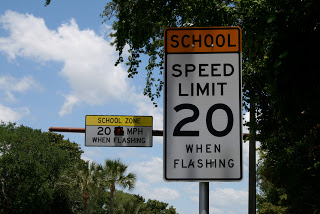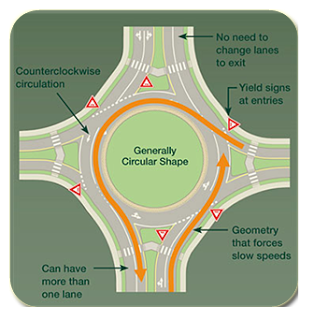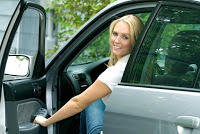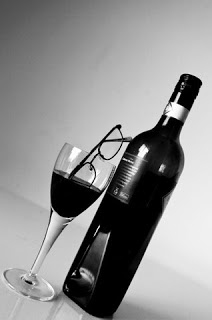
School Zone Safety
October 4, 2012
The next time you’re driving through a school zone, put yourself in the shoes of the students getting on or off the bus and crossing the streets and you’ll know it is a highly unpredictable driving situation. You’ll see extra heavy traffic of parents picking up their kids and the students crossing the street on foot and on their bicycles. After you take in the scene of the organized chaos, you’ll understand why school zone speed limits are strictly enforced.
Here are a few school zone safety tips and all drivers to keep in mind:
Why is it so difficult for children to see motorists? Because their peripheral vision is about one-third narrower than an adult’s, children can’t see a motorist approaching from the right or left as soon as an adult can.
Children also have difficulty judging a car’s speed and distance. They often think that if they can see the driver, the driver can see them.
Drivers should observe speed limits at all times, but especially around children. You were taught during driver education class to always expect children to dart out in the roadway or be unpredictable. So, the next time you’re out expect the unexpected when driving in school zones, near playgrounds, or in neighborhoods where children might be playing and SLOW DOWN.
Always yield to pedestrians. When turning left at a green light or making a right turn on red, drivers need to look for pedestrians as well as cars. Pedestrians always have the right of way in these situations.
When a school bus stops you must stop. Never pass a school bus that is loading or unloading children. Passing a stopped school bus is a four point infraction and is very dangerous.
Around most schools the speed limit is either 15 or 20 mph. Special speed limit signs are posted around schools to alert one as they enter the zone. These signs have flashing lights to tell you when the lower speed limit is in effect. There is also a sign to indicate when you have left the school zone.
The BOLT Driven to Distraction Infographic
April 2, 2012
The BOLT Driven to Distraction Infographic explains through images the dangers of distractions while you are driving. Every time you get behind the wheel, you are faced with many potential distractions from the radio, to your passengers, your cellphone, to your fast food. All of these distractions can add up to disaster in a split second. In 2009, from driver distractions nearly 5,500 people were killed, and another 448,000 were injured. Presented as an infographic (created for BOLT by Infographic World) to help you more easily visualize and retain this important information on the dangers and risks of driving while distracted!

Via: Bolt Insurance

Traffic Circles and Roundabouts
December 1, 2011
Traffic circles and roundabouts are a type of road intersection that are gaining popularity throughout the nation. While not really a new idea, they seem to have become more prevalent over the past fifteen to twenty years as city planners and developers seek ways to keep traffic moving more smoothly and safely.
Traffic circles allow traffic to move more smoothly through an intersection without the use of traffic lights by use of a one way circle with “exits” to the intersecting roads. If you have never encountered one, they could be slightly intimidating at first but they are really quite simple and you will find they do keep traffic moving much more smoothly. They also keep the intersection safer by forcing traffic entering the circle to slow down and yield to traffic already in the circle. While traffic must slow to enter the circle, it doesn’t have to stop for red lights which can be especially frustrating when there is no traffic on the cross street.
Most traffic collisions in the US occur at intersections and the most common type of collisions are rear-end collisions. By slowing traffic on entering and keeping all traffic moving in the same direction, traffic circles cut down on the chances for collisions. With no traffic light, there is a zero chance of someone causing a collision by running a red light.
All traffic circles are designed basically the same way. The terms roundabout and traffic circles are often used interchangeably but traffic circles usually refer to larger, multi-lane circles. Traffic entering the circle must slow, wait for an opening in traffic and then enter to the right moving around the circle in a counterclockwise path. Once a driver reaches the “exit” to the road they want to enter, they exit the circle to the right.
If you live in a growing community, you may want to urge your city planners to consider more traffic circles to cut down on traffic congestion.

Don’t Let the Grinch Steal Your Christmas
November 21, 2011
For those with long commutes to work and back and those who drive very little, the driving situation during the holidays can be a nightmarish situation. The holiday season is supposed to be about peace on earth and kindness to others but it seems that, once drivers get caught up in the holiday shopping rush, all of that goes out the window and it is every man for himself. To help you cope with the holiday driving situation and keep you safe on the road, here are a few reminders.
Planning – High gasoline prices have led many to consolidate trips to save money. That is also a good tip for the holiday season:
- Create and try to stick to a shopping list for everyone on your gift giving list. You’ll spend less time and money if you know exactly what you are after. Try to avoid browsing that will lead to impulse buying and keep you out longer.
- Shopping online can help you avoid going out into traffic. You can also order items online for pick-up at your local store so you can do a quick in –pickup – and out.
- Try to get all your shopping done in one or two days; that way you can relax and enjoy the rest of the holiday season.
- Shop early! Retailers are trying to lure customers with early sales so they aren’t stuck with a left over inventory.
- Plan on being stuck in traffic and allow yourself plenty of extra time. That way, you won’t be tempted to take chances behind the wheel and you won’t be as frustrated.
Dealing with other drivers – The frenetic pace of the holiday season seems to bring out the worst in some drivers. Don’t let a “Grinch” driver get to you.
- It seems as if no other time of the year results in as many clogged intersections. When drivers pull out into a clogged intersection and the light changes, everyone is stuck. If you can’t clear the intersection, remain behind the white stop line until the traffic ahead moves enough that you can get all the way across. Remember, if you are stuck in the intersection when the light changes, you could get an automatic ticket from a red light camera.
- Remember that you can’t take the right-of-way; you can only give it up to another driver. If someone tries to hog the right-of-way, give it to them. Fighting for the right-of-way or a parking spot isn’t worth the possibility of a collision or a road rage incident.
- Don’t try to retaliate against another driver by yelling, making gestures, or honking your horn. That type of behavior could tip someone over the edge into a road rage situation.
- Remember the F.I.D.O. principle. Forget It and Drive On. There is nothing you can do to change another driver’s behavior. Just let it go and keep out of their way.
Pedestrians – There will be a lot of pedestrians in parking lots and on the roads at this time of year.
- Remember that pedestrians always have the right-of-way.
- Small children are excited and even more impulsive at this time of year. Anticipate that they may run out into traffic.
- Pedestrians may be bundled up against the cold. Hats, mufflers and scarves may interfere with vision and hearing. Count on pedestrians not noticing your approach.
Distractions – As if the driving situation isn’t bad enough during the holiday season, distracted drivers make it worse.
- It is understood that you are in a rush, but try to avoid eating in the car while driving. Trying to eat and drink distracts us from the very important job of watching the road ahead. Giving yourself time to eat in a restaurant will allow you to relax and calm down before going back out into traffic.
- Put the cell phone away! Don’t try to use your cell phone and especially don’t text unless you are pulled safely off the road. Cell phone users tend to slow traffic and you don’t want to add to the congestion.
Have a happy and, above all, a safe holiday season with your loved ones.

Does Europe’s Relaxed Alcohol Attitude Lead To Fewer Drinking Problems?
October 20, 2011
In the debate over drinking age limits and DUI issues, comparisons often arise about Europe’s relaxed drinking attitude vs. America’s somewhat puritanical attitude toward alcohol. The comment is often made that Europe has a much more relaxed attitude toward drinking and they don’t seem to have nearly the problems that America has when it comes to binge drinking and driving under the influence.
It is true that Europeans, especially along the Mediterranean coast, have long had a much more relaxed attitude toward drinking. Wine seems to be a part of every meal, whether at home or in restaurants. In the evenings, sidewalk cafes are crowded with patrons enjoying a drink while relaxing with their friends. Young people are exposed to alcohol much earlier and many see little harm in allowing children a small sample of wine now and then. Some European countries allow drinking as young as 16 and some have no age limit laws at all. However, as is often the case, what appears on the surface, hides a much greater problem underneath.
US culture has long had an impact on European culture whether through music, movies, or fashions. Unfortunately, another influence from the US seems to be changing European drinking attitudes, especially among young people. Britain has had an ongoing problem with binge drinking and, over the last ten to twenty years, that problem has crossed the English Channel into Europe proper. The issue has become a major health issue leading to more limitations on drinking among young people and much tougher DUI laws for all.
Social scientists in America and the European Union (EU) consider drinking to excess as a major health issue and define binge drinking as consuming five or more drinks at a single occasion. Several studies sponsored by the EU point to binge drinking as a major social and health issue. Previously, drinking was seen as a social custom – friends sharing one or two drinks while discussing the issues of the day in a sidewalk cafe – and drunkenness was a rarity. Now, especially among younger people, the goal of drinking is to get drunk and that has led to problems of binge drinking and with that, problems of increased crime, vandalism, injuries, and death.
A study sponsored by the European Commission and by the Health Ministries of four different nations revealed that, in 2006, 80 million Europeans, aged 15 and above, had reported binge drinking at least once a week. That is one-fifth of the EU’s adult population. A report from Germany showed that the number of admissions into hospitals for alcohol poisoning had more than doubled in just six years between 2001 and 2006.
The problem has become so acute that 87% of EU citizens now feel that drinking ages should be raised and alcohol advertising directed at youth should be banned. Some cities, such as Lyon France, have banned the sale of bottled alcohol in stores after 10:00 PM to discourage drinking by young people and there is more talk about limiting the sale of alcohol to young people throughout the EU.
The European Commission study also showed that, just like in the US, one-third of all traffic deaths are due to alcohol use. If Americans think that Europe’s drinking and driving laws are more relaxed than ours, they should think again. The EU has suggested that all EU states adopt a Blood Alcohol Content (BAC) of no more than 0.05 as the legal limit for DUI. Several countries, such as Estonia, Poland, and Sweden have gone way beyond that, setting the legal limit at 0.02 BAC. Romania and Slovakia allow no measurable amount of alcohol at all (0.00 BAC) in their drivers. Ireland, the last hold-out at 0.08 BAC, just recently lowered their limit to 0.05 BAC.
It seems that, no matter where alcohol is used, its abuse causes problems and people are willing to take drastic measures to cut down on its availability and use.
